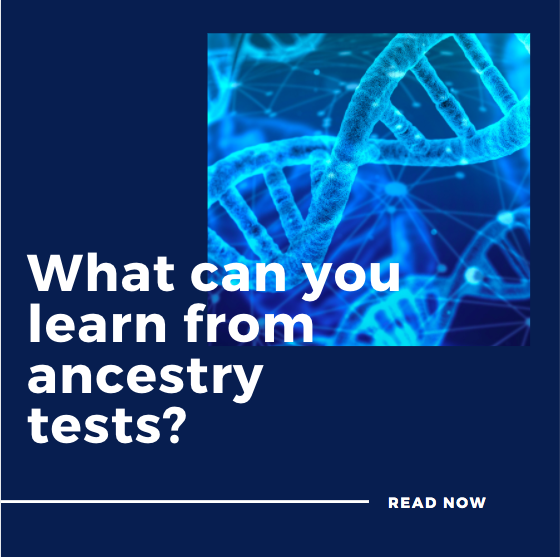The recent advancements in direct to consumer (DTC) genetic testing has made it easier than ever to understand the past on a molecular level. The projected growth of the DCT genetic testing market by 2025 is upwards of $2.5 billion (Ugalmugale, 2019) which clearly illustrates the growing curiosity in understanding the self. Currently, on a commercial scale, three main types of genetic tests are available – Autosomal DNA, Y-chromosome and Mitochondrial DNA – which all offer a different lens on genetic identity.
Autosomal DNA testing refers to the analysis of nucleotides in all 22 of the non sex determining chromosomes. In this variant of DTC genetic testing the most common single nucleotide polymorphisms (SNPs) are analyzed to provide information about the past few ancestral generations. SNPs are a type of genetic variation where a single base code is altered in a particular length of DNA. These variants can communicate details such as “ethnicity” by identifying frequency of matches within a database of modern ethnic groups. This type of testing also helps identify generational proximity of relations with moderate accuracy up-to 4 generations, but are unable to indicate the exact relative – for example the percentage DNA match can pinpoint the connection to this person is of a grandparent but not which one (Sampson, Kidd, Kidd, & Zhao, 2011).
To gauge understanding of precise lineage Y chromosome and mitochondrial DNA tests are used. Both these tests determine ancestry by distinguishing haplogroup assignment. A haplogroup refers to a particular group of people who share a common ancestor and is also derived from SNPs. Since the mutations occur in the non-recombining part of the DNA, with proper analysis of these mutations an accurate picture of descendants and ancestors can be created.
For patrilineal ancestors Y-chromosomes are analysed, which are only found in males. Analysis is fairly simple, when a Y-DNA haplogroup is matched it means that they share a common ancestor. In some DTC testing sites a map of origins which outlines ancestral migration often accompanies these results allowing customers to view the distribution of their haplogroup (Royal, et al., 2010). A precursor of modern patrilineal tests are surname projects still carried out by DTC gene testing companies like FamilyTree.
Matrilineal ancestors are traced exclusively through mitochondrial DNA which is passed from mother to child. This test also uses SNP analysis but the low number of bases pairs, at about 16600, makes it possible to sequence the entire genome of prokaryotic origin (Kivisild T, 2015). Haplogroup analysis is done in the same way as in Y-DNA but cultural norms make surname projects impossible.
In summary, DTC genetic tests allow the customer to trace their maternal and, in the case of males, paternal lineages along with receiving a rough percentage estimate of their combination of ethnicities. These ethnic estimates, with proper analysis, can help in prescription of more effective drugs and in finding out susceptibility to certain diseases – such as the fact that south Asians have a higher susceptibility for type 2 diabetes (Huang, Shu, & Cai, 2015). Autosomal testing, provided that the gene testing company’s database is large enough, may also help find biological relatives.
DTC genetic tests can help confirm predispositions about individual traits and stereotypes from a biological perspective – research indicates that at-least 50% of variants in height can be explained by SNPs (Yang, et al., 2010). However, these tests only provide the singular nature aspect of the parts that compose identity.
Cultural heritage illustrates another part of identity which is influenced by the environment around an individual. This can be seen by a study on Swedish children, both adoptive and biological, which indicated a higher probability of the child becoming an entrepreneur if the parents are also the same (Lindquist, Sol, & Praag, 2012). It can be inferred that the familiarity to environment plays a much larger role than an “inborn ability”.
Things such as religious affiliations and geographical location (Castree, Rogers, & Kitchin, 2013) have a much larger influence on family traditions than lineages. The same is true for ethnicity or ancestry, especially in cases of adopted offspring have a very small role on the culture heritage they hold.
All in all, DTC genetic testing allows people to infer their ethnic composition and identify relatives through the testing for lineage or relation. They illuminate certain behavioural patterns and recurrence of physical traits, which contrasts with the anthropological understanding of cultural heritage.
References and citations
- Ugalmugale, S. (2019). Direct-to-Consumer Genetic Testing Market Size Projections 2019-2025. Retrieved from https://www.gminsights.com/industry-analysis/direct-to-consumer-dtc-genetic-testing-market.
- Royal, C. D., Novembre, J., Fullerton, S. M., Goldstein, D. B., Long, J. C., Bamshad, M. J., & Clark, A. G. (2010). Inferring genetic ancestry: opportunities, challenges, and implications. American journal of human genetics, 86(5), 661–673. doi:10.1016/j.ajhg.2010.03.011
- Huang, T., Shu, Y., & Cai, Y. D. (2015). Genetic differences among ethnic groups. BMC genomics, 16, 1093. doi:10.1186/s12864-015-2328-0
- Lindquist, M. J., Sol, J., & Praag, M. V. (2012). Why Do Entrepreneurial Parents Have Entrepreneurial Children? SSRN Electronic Journal. doi: 10.2139/ssrn.2101543
- Yang, J., Benyamin, B., McEvoy, B. P., Gordon, S., Henders, A. K., Nyholt, D. R., … Visscher, P. M. (2010). Common SNPs explain a large proportion of the heritability for human height. Nature genetics, 42(7), 565–569. doi:10.1038/ng.608
- Castree, N., Rogers, A., & Kitchin, R. (2013). Human geography in A Dictionary of human geography. Oxford: Oxford University Press.
- Kivisild T. (2015). Maternal ancestry and population history from whole mitochondrial genomes. Investigative genetics, 6, 3. doi:10.1186/s13323-015-0022-2
- Sampson, J. N., Kidd, K. K., Kidd, J. R., & Zhao, H. (2011). Selecting SNPs to identify ancestry. Annals of human genetics, 75(4), 539–553. doi:10.1111/j.1469-1809.2011.00656.x

5 Comments on “What can you learn from ancestry tests?”
цветущий веб ресурс http://www.soclaboratory.ru/bitrix/redirect.php?event1=&event2=&event3=&goto=https://westcall.ru/virtualnyy-server/
хорош сайт https://www.htcdev.com/?URL=https://b2b-creative.ru/petrozavodsk/site-audit/
That means you’ll see some fresh features and press access to additional channels where you can gain visibility, without having to modify import of some confused, vade-mecum migration process. https://googlec5.com
this contact form Umee wallet keplr
качественный сайт https://balashiha.charuni.ru/kosmetologiya-kosmetolog/